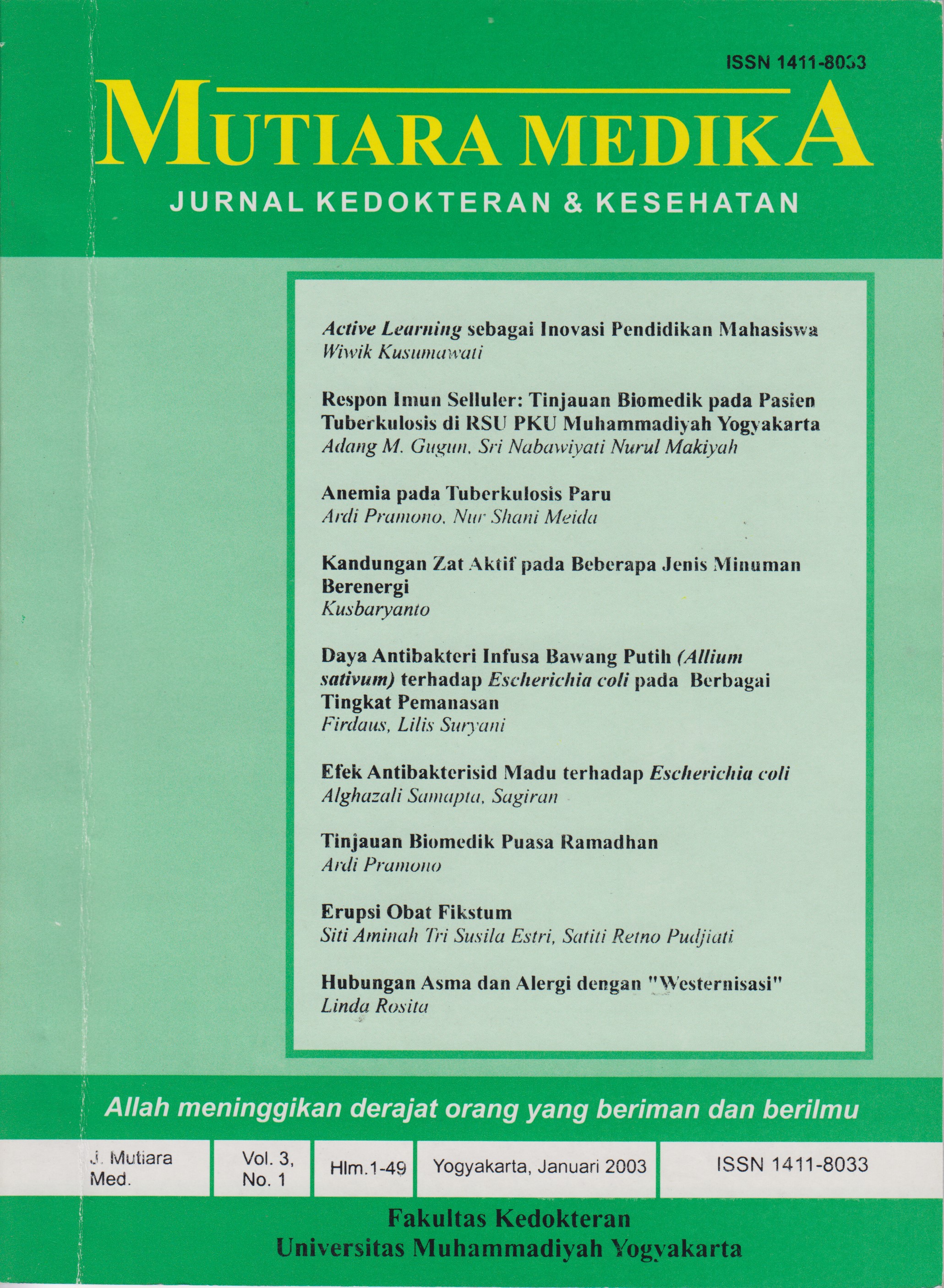Daya Antibakteri Infusa Bawang Putih (Allium sativum) terhadap Escherichia coli pada Berbagai
DOI:
https://doi.org/10.18196/mmjkk.v3i1.1547Keywords:
Bawang putih, Escherichia coli, Kadar Hambat Minimal, Allium sativum, Minimal Inhibitory ConcentrationAbstract
Garlic (Alliums sativum) is one of medicine plants known by people for a long time. It has been known for its antibacterial effect. In 1944, Cavallito in New York found Allicin, a substance that has special quality as antibacterial. However, it is an unstable substance and easily destroyed by heat and can be disintegrated into sulphur compound. Most people consume garlic by cooking it previously. It is difficult to be consumed raw because it can stimulate gastric juice and salivary gland. Gar¬lic is also irritative as well as has sting odor. By using Macrobroth dilution method, the antibacterial activity of garlic infusion was examined at various levels of heat. The Infusion can be made based on the Indonesian Book of Pharmacology, with modification in various temperatures (37°C - 100°C). Escherichia coli ATCC 25922 and local strain, the collection of Microbiology Laboratory of Medical Faculty Yogyakarta Muhammadiyah University, were used as the bacteria tested. The result of the study were: infusion of garlic (Allium sativum) had anti-bacterial activity against Escherichia coli, the heat influenced minimal in¬hibitory concentration of garlic against Escherichia coli and the 80°C heat¬ing of garlic infusion produced the most effective antibacterial capacity (3.38 gr %).
Bawang putih {Allium sativum) merupakan salah satu tanaman obat yang sudah dikenal sejak lama oleh masyarakat. Bawang putih diketahui dapat digunakan sebagai obat antibakteri. Pada tahun 1944 Cavallito di New York menemukan Allicin yang merupakan zat berkhasiat sebagai antibakteri. Allicin merupakan zat yang bersifat tidak stabil dan mudah rusak oleh pemanasan. Allicin dapat terurai menjadi senyawa sulfur. Sebagian besar masyarakat mengkonsumsi bawang putih dengan dimasak dulu. Bawang putih sulit dikonsumsi secara mentah karena dapat merangsang asam lambung, kelenjar ludah danbersifat iritatif serta baunya menyengat. Dengan menggunakan metode pengenceran tabung (Macrobroth dilution) dilakukan uji daya antibakteri infusa bawang putih dengan berbagai tingkat pemanasan. Infusa dibuat sesuai dengan yang termaktub dalam Farmakope Indo¬nesia, dengan modifikasi pada variasi suhu pemanasan (37°C-100°C). Bakteri uji yang digunakan adalah Escherichia coli ATCC 25922 dan strain lokal, koleksi Laboratorium Mikrobiologi, Fakultas Kedokteran Universitas Muhammadiyah Yogyakarta. Hasil penelitian menunjukkan bahwa: infusa bawang putih {Allium sativum) memiliki daya antibakteri terhadap Escherichia coli, pemanasan mempengaruhi kadar hambat minimal infusa bawang putih terhadap Escherichia coli, pemanasar infusa bawang putih {Allium sativum) dengan suhu 80°C menghasilkan days antibakteri yang paling efektif sebesar 3,38 gr%.
References
Departemen Kesehatan RI, (1974), Vademukum Bahan Obat A lanr,260-262.
Hasan, (1999), Pokok-Pokok Materi Satatistik 2, 166-169, Bumi Aksara, Jakarta.
Josling, (1999), Garlic as an Antibiotic, The Garlic Information Center, garlic @ mistral.co.uk.
Josling, (1999), Garlic Specialty Chemicals Availabel For Purchase, The Garlic Information Center, garlic @mistral.co.uk.
Josling, (1999), Allicin is the Key Component From Garlic, The Garlic Information Center, garlic @mistral.co.uk.
Nadesul, H. (1993), Dari Balik Kamar Praktek Dokter, 4 ed., 114-122, Puspa Swara, Jakarta.
Roser,D. (1999), Bawang Putih Untuk Kesehatan, Bumi Aksara Jakarta.
Yoshida,H.et al.(1999), Antimicrobial Activity Of The Thiosulfinates Isolated From Oil Macerated Garlic Extract, 63 (3): 4-591, Biosci Biotechnol Biochem.
Downloads
Published
Issue
Section
License
Copyright
Authors retain copyright and grant Mutiara Medika: Jurnal Kedokteran dan Kesehatan (MMJKK) the right of first publication with the work simultaneously licensed under an Attribution 4.0 International (CC BY 4.0) that allows others to remix, adapt and build upon the work with an acknowledgment of the work's authorship and of the initial publication in Mutiara Medika: Jurnal Kedokteran dan Kesehatan (MMJKK).
Authors are permitted to copy and redistribute the journal's published version of the work (e.g., post it to an institutional repository or publish it in a book), with an acknowledgment of its initial publication in Mutiara Medika: Jurnal Kedokteran dan Kesehatan (MMJKK).
License
Articles published in the Mutiara Medika: Jurnal Kedokteran dan Kesehatan (MMJKK) are licensed under an Attribution 4.0 International (CC BY 4.0) license. You are free to:
- Share — copy and redistribute the material in any medium or format.
- Adapt — remix, transform, and build upon the material for any purpose, even commercially.
This license is acceptable for Free Cultural Works. The licensor cannot revoke these freedoms as long as you follow the license terms. Under the following terms:
Attribution — You must give appropriate credit, provide a link to the license, and indicate if changes were made. You may do so in any reasonable manner, but not in any way that suggests the licensor endorses you or your use.
- No additional restrictions — You may not apply legal terms or technological measures that legally restrict others from doing anything the license permits.






